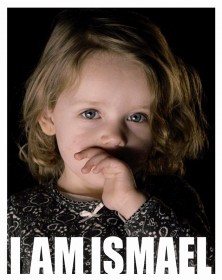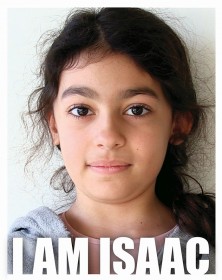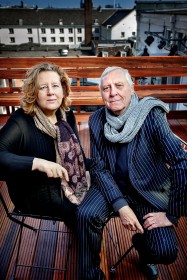Starting on May 22 the Jewish Museum Berlin will present the exhibition “Obedience” by filmmaker Peter Greenaway and multimedia artist Saskia Boddeke. Designed as an installation in fifteen rooms the exhibition refers to the story of forefather Abraham, who is willing to obey God’s command and sacrifice his son. The two artists use film projections, installations, precious objects, and sound effects and music to stage the biblical narrative as a sensuous and immersive showpiece. For Saskia the “beating heart” of “Obedience” is the film installation “I’m Isaac / I’m Ishmael” which will be presented at the beginning of the exhibition. Children and young adults from all over the world are now being invited to become part of this installation:
In order to encourage our readers to follow this call, make a video and send it to the artists “Blogerim” spoke with Saskia about the idea of the installation and her artistic vision.
Mirjam Wenzel: The biblical story in the Book of Genesis 22 starts with the voice of God telling Abraham to take his son to the land of Moriah for a burnt-offering. But your exhibition will start with the voice of Isaac and Ishmael. Why?

Film still from the installation “I’m Isaac / I’m Ishmael” © Jewish Museum Berlin, photography: Saskia Boddeke, please send your clip to: isaac@luperpediafoundation.com
Saskia Boddeke: For me the most important characters in the whole story are Isaac and Ishmael. They stand for the children that deserve the right to be protected and to live in a world without wars. They provide the opportunity to identify with so many children and young adults all over the world.
You have now initiated a crowd sourcing campaign asking people to say either “I am Isaac” our “I am Ishmael” into the camera and become part of your installation. Is there a difference between the speech act of identifying with Isaac on the one hand and with Ishmael on the other?
In the Torah it’s Isaac who is going to be sacrified. In the Koran the name is not mentioned but there has been quite some discussion if it’s Isaac or Ishmael until some very important men decided that it’s Ishmael. I don’t think it matters whether it is Isaac or Ishmael and I use this confusion in the installation. Isaac and Ishmael are symbolizing any child that is a victim of war and violence.
The name Isaac is given by Sarah to her son. Sarah didn’t expect to still get a child and so she called him “He will laugh” (and make me laugh, too). Does laughing have a special meaning for your installation?

Film still from the installation “I’m Isaac / I’m Ishmael” © Jewish Museum Berlin, photography: Saskia Boddeke, please send your clip to: isaac@luperpediafoundation.com
Yes, because in all the three stories (meaning in the three religions Judaism, Christianity and Islam) the females don’t really play an important role: In the Koran Sarah or Hagar are not mentioned by name. We decided to dedicate a special room to the female figures in which the meaning of Isaac’s name: “He, who makes me laugh” turns into “He, who makes me cry”. The children Ishmael and Isaac are taken away from their mothers and they are not being told why. You can read in the text from a church father that Abraham was right not to inform his wife about the reason he took Isaac away. Sarah would have behaved like a woman. She would have stopped Abraham and convinced him to be disobedient to his God, that’s why he needed to lie to her. The Sarah and Hagar room is dedicated to the perspective of the females. ‘Zam zam’ bottles are hanging down from the ceiling, it will be as if the ceiling is crying.
Your installation in fifteen rooms is called “Obedience”: How does the “I am Isaac”-installation refer to the demand to obey – be it to God, to the law or to another supreme authority?
Our installation will finally move away from the biblical story and look at young adults in war: We sacrifice our youth to have peace and that is what our exhibition is about. The question of obedience to God and his will becomes a question of obedience to society, to the pressure of society to maintain what we have.
So the visitor begins his tour through the exhibition identifying with the perspective of the child and slowly starts to wonder: “Maybe I’m rather Abraham?”
The visitor will find our installation interesting and quite beautiful in the beginning but start to feel more and more uncomfortable when they follow the path through the installation. At the end the question will be asked: Or are you Abraham? Meaning: Would you sacrifice your child? How do you behave when children of others are sacrificed? In the end the pain of those whose children are being sacrificed will become everyone’s pain.
The interview was conducted by Mirjam Wenzel on behalf of “Blogerim”

I saw this exhibition in Berlin last Saturday! I was so moved, so touched…. It was an extraordinary experiances which lasts until now! Thanks for that! It could be amazing to visit this exhibition in Warsaw/Poland.
Greetings from Warsaw,
Darek